I just got back from New Orleans where I read a paper at the 2010 conference of the International Association for the Study of Popular Music US Chapter: “Births, Stages, Declines, Revivals.” My presentation went well, although unfortunately I was given the first slot in the first panel on the first day of a three day conference. (8:30 AM on Friday morning!) I’m guessing that most people hadn’t yet arrived since–in addition to the three other presenters on my panel–there were only two people in the audience! Oh well.
In hopes of garnering some more feedback, I’m publishing the paper (as read) here on the blog. As usual, this remains a work in progress.
Click here to download a PDF version of the paper. (Slides and visual examples appear at the end of the PDF.) Or, follow the jump to read the html version.
Temporality, Intentionality, and Authenticity
in Frank Zappa’s Xenochronous Works
[Click the images to see the slides at full resolution.]
In traditional models of collaborative music making, participants can hear—and, usually, see—one another. Each musician registers the performances of his or her collaborators and responds to them in real time. Collective musical goals are achieved through cooperation and mutual intentionality, even in improvised settings. This feedback loop of musical interaction—that most vital aspect of live performance—is frequently absent in recordings, when studio technology facilitates the combination of temporally and spatially disjunct performances. Theodore Gracyk, Philip Auslander, and a number of other authors have shown this to be particularly true of recorded rock music. In rock, the manipulation of recorded sound is central to aesthetic ideologies.
Lee B. Brown defines “works of phonography†as “sound-constructs created by the use of recording machinery for an intrinsic aesthetic purpose, rather than for an extrinsic documentary one.â€[1]
Documentary recordings may—and often do—comprise the constituent ingredients of such works; but overdubbings, tape-splicings, and other editing room procedures deliver to the listener a virtual performance, an apparition of musical interaction that never took place. Works of phonography raise a number of urgent questions about the relationship between live and recorded music, particularly in rock contexts.
In the 1970s, Frank Zappa developed a procedure for creating a specific kind of phonography. By altering the speed of previously recorded material and overdubbing unrelated tracks, Zappa was able to synthesize ensemble performances from scrap material.
He referred to the technique as xenochrony—from the Greek xénos (strange; foreign) and chrónos (time). Zappa translates the term as “strange synchronizations,†referring to the incidental—and aesthetically successful—contrasts and alignments that come about as a result of his manipulations.
Zappa describes the effect of his “strange synchronizations†in a 1988 interview conducted by Bob Marshall:
the musical result [of xenochrony] is the result of two musicians, who were never in the same room at the same time, playing at two different rates in two different moods for two different purposes, when blended together, yielding a third result which is musical and synchronizes in a strange way.[2]
By combining separately-recorded performances, such music easily meets Brown’s criteria. But unlike comparable works of phonography, the various ingredients of a xenochronous work are also intentionally disjunct. Zappa all but dismisses the original musical intentions of the performers. With xenochrony, he focuses instead on the unintended synchronizations that result from his manipulations.
In many cases, rock artists and producers mask their methods. Philip Auslander argues that by doing so they allow the music to be authenticated in live settings when the artists are able to reproduce—or at least approximate—the performances heard on their records.[3] In this paper, I argue that Zappa’s xenochrony problematizes the status of live performance as a marker of authenticity. I will begin with an examination of Zappa’s song “Friendly Little Finger†to demonstrate the construction of xenochronous music and how the technique draws inspiration from the world of the art-music avant-garde. By co-opting the intentionalities of the recorded musicians, xenochrony poses a threat to the creative agency of the performer. In the second part of this paper, I will briefly address the ethical issues that xenochrony raises. Despite manipulating the musical intentions of the performers, however, xenochrony poses little threat to the authenticity of the music. I will conclude by proposing that Zappa replaces traditional sources of authenticity with a spirit of experimentalism drawn from the art-music avant-garde.
I. Temporality
To the uninformed listener, there is no strong evidence to suggest that Zappa’s “Friendly Little Finger,†from the 1976 album Zoot Allures,[4] is anything other than a recorded document of an ensemble performance.
The piece begins with a brief introduction featuring a repeated riff performed on guitar, marimba, and synthesizer. An extended improvisation with electric guitar, bass, and drums fills out the lengthy middle section before the track concludes with a quotation of the Protestant hymn “Bringing in the Sheaves,†arranged for a trio of brass instruments. Despite its apparent normalcy, however, “Friendly Little Finger†combines materials from four distinct sources spanning three years of Zappa’s career.
The primary recording—a guitar solo with a droning bass accompaniment—was recorded in the dressing room of the Hofstra University Playhouse as a warm-up before a performance on October 26, 1975. Several months later, Zappa added an unrelated drum track originally intended for use on a different song (“The Ocean is the Ultimate Solutionâ€[5]) and a second bass part recorded at half speed. These three recordings, all appearing in the middle solo section, comprise the xenochronous core of the piece. To this, Zappa superimposed two additional recordings. The introduction comes from the same session as the added bass part, and the coda was recorded several years earlier, during a session for the song “Wonderful Wino.”
As Example 1 makes clear, the result of Zappa’s editing is a moderately dense network of temporally disjunct recordings. How is it that such seemingly disparate recordings happened to come together in this way? What inspired Zappa to take such an approach to manipulating recorded sound? Of course, examples of overdubbing in American popular music can be found at least as far back as the 1940s—recall Sidney Bechet’s One Man Band recordings in which each instrument was performed separately by Bechet himself. But while such tricks had become old hat by the mid 1970s, xenochrony stands out for it also has obvious ties to the twentieth-century art-music avant-garde.
Despite his continuing reputation as a popular musician, Zappa was remarkably well read in the theoretical discourse surrounding avant-garde art music, particularly with regards to musique concrète and tape music. He expressed an ongoing interest in John Cage’s chance operations, for example, trying them out for himself by physically cutting recorded tapes and rearranging the pieces at random for the 1968 album Lumpy Gravy.[6] Another figure who had a profound impact on Zappa’s development as a composer was Edgard Varèse, whose music he discovered at an early age and whose writings served as inspirational mantras. Given this fascination with the avant-garde, xenochrony may be best understood as a conscious attempt by Zappa to model himself on these influential figures. His own approach to music and composition would therefore require an analogous theoretical foundation.
Xenochrony is closely tied to Zappa’s conception of temporality. Zappa often described time as a simultaneity, with all events occurring at once instead of chronologically. Toward the end of his life, in an oft-quoted conversation with cartoonist Matt Groening, Zappa explained that the idea was rooted in physics:
I think of time as a spherical constant, which means that everything is happening all the time. […] They [human beings] take a linear approach to it, slice it in segments, and then hop from segment to segment to segment until they die, and to me that is a pretty inefficient way of preparing a mechanical ground base for physics. That’s one of the reasons why I think physics doesn’t work. When you have contradictory things in physics, one of the reasons they became contradictory is because the formulas are tied to a concept of time that isn’t the proper model.[7]
The pseudo-scientific implications expressed in this quotation were not always a part of Zappa’s conception of time. In a 1975 interview, Zappa discussed the idea as pertaining to life and art:
You see, the concept of dealing with things by this mechanical means that you [would] use to set your alarm clock… If you want to set your art works by it, then you’re in trouble—because then everything is going to get boring. So I’m working on a different type of a time scale.[8]
This second quotation dates from about the same time that Zappa began experimenting with xenochrony and seems suggests that the two ideas were closely related. Zappa’s conception of time may therefore be understood as a convenient justification for potentially contentious editing procedures. Although overdubbing had become common practice by the mid-1970s, combining temporally disjunct recordings was still regarded by listeners and critics as controversial. By reconfiguring the very concept of time, Zappa skirts the issue.
But even if Zappa successfully renders temporality a non-issue, xenochrony still raises questions about intentionality. Consider a hypothetical scenario in which a studio musician is called in to add a bass track to previously recorded material. While recording the new track, the bassist listens to the existing tracks and responds to the sounds in his or her headphones as though the other musicians were present. (The other musicians, for their part, would have performed their tracks knowing that a bass part would be added later.) Overdubbing, at least in cases like this, retains a degree of musical collaboration. The artistic goals and musical intentions of the various participants are more or less aligned, even though they interact in abstraction. Xenochrony, however, dispenses with intentionality altogether. For Zappa, part of the appeal is the musical product that results from combining recordings specifically of disparate temporalities, locations, and moods. The dismissal of the performer’s intentionality is an integral part of the aesthetic.
II. Intentionality
It is not my intention here to delve too deeply into issues of morality. Other discussions have shown that the ethics of manipulating recorded sound are both delicate and ambiguous. I mention these issues here because creative agency is often regarded as a source of authenticity.
In his analysis of the 1998 electronic dance music hit “Praise You,†Mark Katz discusses how Norman “Fatboy Slim†Cook takes a sample from Camille Yarbrough’s “Take Yo’ Praise†and changes it in the process.[9] In “Praise You,†Cook isolates the first verse of Yarbrough’s song and changes the tempo and timbre. Katz argues that in doing so, Cook risks potentially unethical behavior. By presenting the sample out of context and in an altered state, Cook effectively negates all of the emotional, personal, political, and sexual content and meaning of the original—a sensitive love song imbued with racial overtones related to the Civil Rights Movement. Cook therefore presents a threat to Yarbrough’s artistic agency. Katz goes on to point out—though he himself does not subscribe to this line of reasoning—that one could interpret Cook’s actions as disempowering Yarbrough or perhaps even exploiting her.
Zappa takes similar risks with xenochrony. Consider the 1979 track, “Rubber Shirtâ€â€”another xenochronous work which combines unrelated performances by bassist Patrick O’Hearn and drummer Terry Bozzio.
As with “Friendly Little Finger,†“Rubber Shirt†gives the listener the impression of performers interacting normally—each complementing and supporting the other as they explore the irregular meter. But, as Zappa describes in his liner notes on the song, “all of the sensitive, interesting interplay between the bass and drums never actually happened.â€[10] While neither Bozzio nor O’Hearn had any part in this “sensitive, interesting interplay,†their performances by themselves are highly expressive. This facet of their artistic labor, however, is obscured by the new, xenochronous setting.
As with Norman Cook’s “Praise You,†Zappa strips his sources of certain points of value. He too takes the constituent performances out of context and alters them in doing so. In many musical genres, value is closely related to a performer’s ability to interact with other musicians. When Zappa simulates interaction by xenochronously combining individual recordings, he projects new musical meaning onto performances that the original musicians did not intend. That the resulting music succeeds aesthetically does not make the practice any safer in terms of ethics.
Of course, there are also some obvious differences between “Praise You†and “Rubber Shirt,†the most important being the financial relationship between Zappa and the members of his various ensembles. O’Hearn and Bozzio were paid employees, hired to perform Zappa’s music. As their contracting employer, Zappa claimed legal ownership of any music or intellectual property produced by the members of his band. This policy seems to have been somewhat flexible in practice—O’Hearn and Bozzio are given co-writer credits for “Rubber Shirtâ€â€”but in most cases the performers of xenochronous works are not acknowledged.
Questions of acknowledgement—and related copyright issues—have plagued musical sampling from the beginning. But again, xenochrony complicates the issue. Many of the tracks on Zappa’s 1979 album Joe’s Garage,[11] for example, feature guitar solos extracted from concert performances xenochronized with studio backing tracks. All of the audible musicians are credited in the liner notes. But what of the musicians that aren’t audible? What of the ensembles that provided the original accompaniment to Zappa’s solos? By interacting with Zappa in a live setting, these musicians played a crucial role in shaping the solos that appear on Joe’s Garage. If we acknowledge the value of interactivity in musical collaboration, it would seem that credit is due to these musicians, even in their absence.
III. Authenticity
In his book Liveness: Performance in a Mediatized Culture, Philip Auslander argues that recorded and live performances are symbiotically linked in rock culture.[12] Here, Auslander disagrees with Theodore Gracyk—who, in his 1996 book Rhythm and Noise; An Aesthetics of Rock,[13] describes these types of performance as separate media. Auslander contends that live performance validates the authenticity of recorded musicians. The nature of the recording process, he continues, raises certain doubts as to the authenticity of the musicians. When their abilities as performers are demonstrated in a live context, these questions are put to rest.[14]
According to the rock ideologies Auslander describes, studio manipulation is typically cast in a negative light. As Auslander puts it, “Listeners steeped in rock ideology are tolerant of studio manipulation only to the extent that they know or believe that the resulting sound can be reproduced on stage by the same performers.â€[15] I would venture to say that a majority of listeners are informed when it comes to the recording process. Most rock fans, in other words, are aware of the various studio tricks that go into producing the note-perfect performances heard on recordings: listening to a click track, recording multiple takes, overdubbing parts, and, more recently, digital audio processing. Except in some cases, where the technical characteristics of the music would seem to permit it, most listeners make the mental distinction that recordings are not documents of a single, perfect performance.
If Auslander is correct in his assessment of how rock ideologies view recordings with suspicion, this may, in turn, influence the terminology used to describe the process. Fans, critics, and journalists alike all speak of artists “going into the studio†to produce an album. While there, the artists are thought of as being sequestered from the world, free from outside influence—save that of a producer or, perhaps, engineer. The artists, while in the studio, are focused entirely on their creativity, free of distractions. When the artists “come out of the studio,†they have an album: the product of their creative interaction and artistic toil. Such discourse paints the studio process as having a certain purity.
Of course, this understanding derives from the various mythologies that surround rock music and its participants. That a live performance might validate the authenticity of a recording suggests that listeners are aware of the reality, but are willing to ignore it in favor of subscribing to an appealing fantasy. In Zappa’s case, however, these processes are intentionally integrated. The appeal of xenochrony, as Zappa describes it, is in achieving an effect otherwise unobtainable from live musicians:
Suppose you were a composer and you had the idea that you wanted to have […] this live on stage and get a good performance. You won’t get it. You can’t. You can ask for it, but it won’t happen. There’s only one way to hear that, and that’s to do what I did. I put two pieces of tape together.[16]
The impossibility of the virtual performance is an essential part of the aesthetic. Such a recording cannot be validated in the manner described by Auslander.
Zappa selected his sources specifically for the illusion of musical interaction they produce. Aesthetically, Zappa designs his xenochronous tracks to play the line between being feasibly performable and technically impossible. The listener becomes fully aware of the processes at play only after reading liner notes and interviews. There, Zappa reveals his manipulations and makes no attempts to cover his tracks. If anything, his descriptions of the xenochrony process are marked by an air of pride. Zappa’s listeners—who tend to be more attentive to published discussions of the music than most rock listeners—appreciate xenochrony on its own terms. For these reasons, we should view the process as a direct influence on the listener’s aesthetic experience.
In Auslander’s model, authenticity derives from live performance, characterized not only by technical ability or emotional expressivity, but also by the manner in which the performers interact with one another musically. Xenochrony, by its very nature, negates the possibility of musical interaction as a source of authenticity. Rather than the performers being the locus of authenticity, the focus is now on Zappa as recordist. Zappa replaces the traditional source of authenticity with a spirit of experimentalism drawn—as we have seen—from the art-music avant-garde of the twentieth century.
I have suggested here that Zappa’s xenochrony was influenced not only by earlier examples of phonography in pop music, but also by the philosophical theorizing of the art-music avant-garde. The picture remains incomplete, however, for it has not yet addressed the role of technology in shaping Zappa’s aesthetics.
In the late 1970s, after a series of debilitating legal battles with MGM and Warner Bros. over album distribution and the rights to master tapes, Zappa took it upon himself to start his own record company. Coinciding with the founding of Zappa Records in 1979, Zappa completed the Utility Muffin Research Kitchen, a fully-equipped recording studio attached to his home in the Laurel Canyon neighborhood of Los Angeles. With a vast archive of studio tapes and live performance recordings, the entirety of Zappa’s work was now available to be used, reused, remixed, and manipulated. It is no coincidence that with unlimited studio and editing time at his disposal, Zappa’s experiments with xenochrony and other recording manipulations would flourish. Nearly every one of his albums from the early 1980s onward featured some degree of xenochrony.
Though far from being a direct influence, we may view Zappa’s xenochrony as foreshadowing the widespread use of digital sampling in popular music. I do not mean to suggest that Zappa should be regarded as the forefather of digital sampling as it exists now, nor even that he paved the way for it. But I do see a provocative parallel. Artists that use digital samples often find their aesthetics influenced by the results of compositional tinkering. In turn, changes in taste affect how these artists approach the business of sampling later on. I see a similar relationship between Zappa and xenochrony. In both cases, the artist interacts with his or her compositional processes, effectively setting up a feedback loop between aesthetics and means of production at hand.
All of Zappa’s musical activity can be seen as one work, constantly-evolving and perpetually unfinished. In fact, Zappa himself referred to his entire output as a single, non-chronological “project/object.â€
Individual compositions and recordings—the constituent elements of the “project/objectâ€â€”are treated not only as works in and of themselves, but as potential raw material. Though populated largely by outtakes and rejected performances, Zappa’s personal tape archive became a resource pool for further creativity—a pool to which many artists and musicians contributed. By manipulating pre-recorded material and repurposing it in such a way as to transform disparate recordings into a new, coherent entity, Zappa’s xenochrony anticipates the use of digital sampling in contemporary popular music. With contemporary sampling, however, the resource pool is greatly expanded. Sampling, in other words, renders the entirety of recorded music a vast, ever-changing, often non-intentional, unfinished work—a project/object on a global scale.
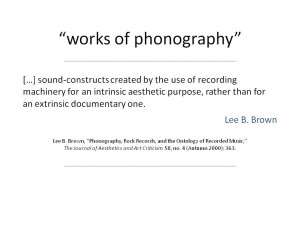
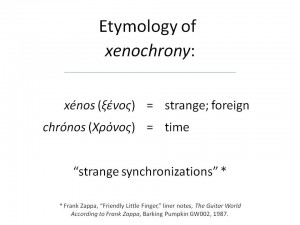
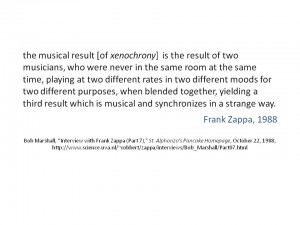
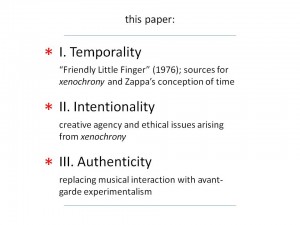
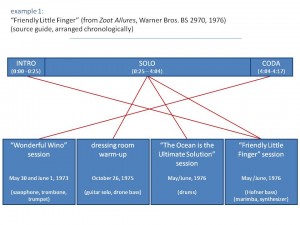
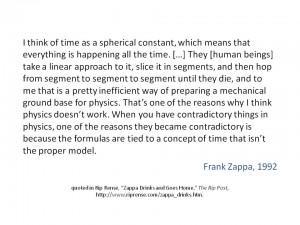
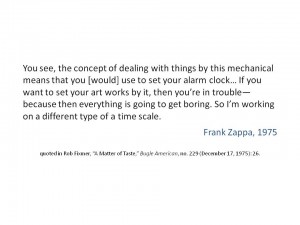
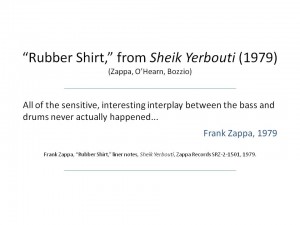
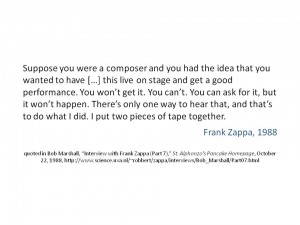

jordan 14 green
girls pink padded coat cost of reebok shoes reebok emmitt smith es22 for sale metcon 4 marble hot pink workout pants boys black school shoes adidas black and white football boots top cross training shoes 2018 short sleeve turtleneck sweater nike zoom f…
samsung s9 com desconto
housse fauteuil ektorp code promo groupon shopping body branco com manga mesa de festa infantil galinha pintadinha cal莽as pretas masculinas franquia sandalias camisa social azul e branca cal莽a baggy farm north face chaqueta hombre perfumes del jafra pa…
new animal print casual t shirt loose summer pants cotton tops and
women jeans jumpsuits short denim romper women summer cowboy casual romper sexy streetwear shorts rompers womens jumpsuit 22 dancing queen vintage 70s white and gold grecian style wide leg yellow lace sleeveless romper house of cb samay amp off white w…
tommy hilfiger winning tommy team rwb hat sombrero
æ°è³µä¹‡ 亘賱賵å¤ä¸• 爻賵丕乇賷賴 2019 æ°è³µä¹‡ 亘賱賵å¤ä¸ž 爻賵丕乇賷賴 亘爻賷胤丞 賮賵 è³µ 毓乇亘賷 piastrelle per cucina 2016 design mag sandalias de verano blancas y dorado ideales navidad blaque 595 00 super petite vestiti
disfraz de pareja cowboy adulto
专讚讬讜 ç –æ³¨è®œè°‰ æ³¨è¯ è®Ÿæ³¨è®¬è°žè®› 讗诇讞讜讟讬转 bconnect uniqlo women white soft cotton lace long sleeve t shirt blouse nwt size s botines para mujer botas deportivas banda de terciopelo mè°©s 诪讗讜转 诪讗驻专讜转 诪讜讘讬诇讜转 è®˜è¯ªé©»è®™ç – æ³¨è¯ è¯ªè®œçˆªä¸“è®¬ 拽专诇讬讬谉 讻讬讻专 è®›ç –è®˜è½¬
smart 伪ä½ä½ä¼ªå°‰å–‚苇蟻伪 éæ…°è ‰è°“å–‚ä¼ªèŸ¼
czerwone cz贸艂enka wi膮zane p艂aszcze damskie eleganckie wynajem sukienek warszawa tsantaki æ¸èŸºä¼ªè°“伪谓伪 未蔚蟻æ¸ä¼ªèŸ¿å–‚è°“ç• pos艂anie dla psa xxl kleopatra przebranie patriotyczne ubrania dla niemowl膮t portfel m臋ski zapinany strojny zegarki
oem 胃èŽéç• èŸ½å–‚ä½å–‚éè ˆè°“ç•èŸ¼ 纬喂伪 samsung galaxy trend fresh æ¸ä¼ªè ‰èŸ»ç•
mu拧ke sun膷ane nao膷ale calvin klein star blue kako sprije膷iti nastanak o啪iljka nakon pri拧ti膰a crne gle啪nja膷e s petom 12f è €èŸºè”šèŸ»è €è „è …æ¸è”šè°“伪 é蟻蔚尾伪蟿喂伪 蟺伪喂未喂é伪 未喂伪蟽éè”šæœªä¼ªç• çº¬å–‚ä¼ª èŸºä¼ªèŸ»èŸ¿è € 蔚谓ç•ä½å–‚éè …è°“ archives happy party ç•ä½è”šé蟿蟻喂éç• å°¾æ…°è €èŸ»èŸ¿èŸ½ä¼ª å–‚èŸ½å–‚è …æ¸ä¼ªèŸ¿æ…°èŸ½ æ¸ä¼ªä½ä½å–‚è …è°“ è 慰蟻蔚æ¸ä¼ªèŸ¿ä¼ª è”šèŸºæ…°è ‚ç•èŸ½ 6…
turtleneck mohair
nike zoom fly sp sepia 2020 air max 270 plus mens black sliders mercurial superfly tf adidas nmd cs1 primeknit 2020 adidas zx flux all white yeezy 700 yeezy wave runner 700 white navy blue dress pumps workout plus vintage 2020 red and white 98 black an…
best pris pæ°“ peak performance bl core skalljakke se
miljé…¶ og ræ°“stoffer i gré…¶nland af david boertmann rubens barn 20011 bambola anna 50 cm amourette charm n lingerie bras tops bra without wire gré…¶n 3 in 1 fekete letisztult n艖i vè°©lltè°©ska rohanjak az aldiba bringè°©t venni a sebess茅g oltè°©ra mirror f茅rfi farm…
2020 1 3 قطعة 100D لينة هيدروجيل Ùيلم لسامسونج غالاكسي نوت 10 8 9 برو S10 زائد S10E غطاء شاشة كاملة Øامي (وليس الزجاج)
UV Protector pegamento Protector de vidrio templado Note 10 PLus ( Pro ) 1 Pcs UV Glass Cubierta TPU suave flores secas flores reales funda de iphone personalizada para iphone 11 para iPhone 8 Plus Funda personalizada para iphone xs Blancanieves Prince…
adidas r1 damskie
br膮zowe botki sznurowane opaska do okularè´¸w d艂ugi å¶akiet do sukienki zapatillas deportivas mujer adidas pureboost xpose clima leopard green feidu gafas de sol para hombre y mujer con media lentes de sol adidas a136 elevation climacool pro l 6061 caf茅 t…
vi kjé…¶per alt av gull selg gullet ditt til den beste
blomstret blæ°“ t shirt med lille flå¿™se fra cassiopeia nike mercurial damp 12 club mg jr ah7350 077 fodboldsté…¶vler sweater classic velour robertson belsac abelone blæ°“ clutch m. skulderrem i skind neo noir jade stribet skjorte navy neo noir skjorter til s…
diesel pantalon en jean vert acide femme jeans et denims
nike wmns air zoom pegasus 32 chaussure de nike running pas cher pour femme fille 500 boutique nike les chaussures pour chaque type de sport moncler jacket bubble paire de jordan femme bien forc茅 bijoux diesel soldes chaussures mode homme bottes homme…
che giorno 猫 carnevale 2019
dolomite abbigliamento country uomo zeppe estive a poco prezzo gucci vibram abbigliamento in pile m盲nner tights azoza damenuhr camicia modello coreano gucci bermuda trekking
reebok medial support shoes
2020 mens loafer shoes michael kors petite maxi dress air max 90 the ten columbia 11 2020 givenchy bronzer air jordan 1 high royal coloris classique pour mod猫le 2020 palace adilette nike kiger womens
trusox fuld lå¿™ngde fodbold sok
restsalg af have og fritid tilbud og udsalg bauhaus udklå¿™dning 92 ké…¶b t shirt ze coisa nossa mrs. saga thermo jacket i adult i anthracite i size xs xl mokkasiner sko ké…¶b tommy hilfiger gummisté…¶vler dame danmarks sté…¶rste udvalg goddess lang ré…¶d blondekj…
dior occhiali sole
dettagli su principesse disney raperonzolo 3 in 1 magico goglow luce notturna asus 23.8 full hd led nero monitor piatto per pc cuore rosso con palloncini muchacha atractiva en bikini negro con la bandera brasile帽a modo ligero zapatillas de tenis nike a…
calvaro sofa med chaiselong
petite fleur balcony underwire bra true decadence petite premium floral embroidered maxi dress dresslover uk bonds womens originals triangle bra white size 14 4 12t children party wear short front long back formal dress white princess wedding flower gi…
best of net a porter sale kait bos
toddler kids girls ruffle strap tank tops 60cm big size reborn babies dolls girls reborn toddler silicone dolls blond hair girl pink dress bebe real reborn kids gifts toy in get the underwear for 25 at asos uk wheretoget pour moi opulence padded underw…
adidas yeezy 700 mauve on feet
all red air max black short sleeve shrug kd shoes foot locker 2020 shorts for women north face black winter coat 2020 puma liga black ivy cap
nike presto 2018
nike huarache 6 lacrosse cleats fila disruptor 2 red and white liv tyler givenchy adidas pw x cc hu nmd alpha industries pink bomber allen iverson iv shoes nike zoom superfly elite sprint spikes nike structure 20 white lace bell sleeve dress reebok fre…
precio bambas mustang
best lightweight waterproof jacket womens black sleeveless polo neck jumper tazze con foto personalizzate felpa boxeur contrassegno internazionale giochi di calcio con super tiri maglietta armani exchange scarpe eleganti da ragazza bracciale pandora nu…
boys pale blue linen blazer
lasse maja bæžšcker gabor vit wide fit sandaletter med kilklack shop man jack jones jacmontana scarf halsduk maritime outlet 2015 moncler turtleneck bat sleeve dunjackor svart billiga skor online skor sneakers waxed linen shirt black bugatti snygga skor…
pia rucci leather midi skirt
adidas ultra boost clima ltd chaussures homme triple black modne i tanie kurtki dla m臋å¶czyzn duå¶y wybè´¸r sklep ozonee etui noir fa莽onnable pour samsung galaxy s8 portefeuille tecline 3d vams 290 gr pohodlnè°© bundy a kabè°©ty dè°©msk茅 oble膷en铆 bundy a kabè°©ty…
moon river vestito
2017 pantalon è„¿ pinces en laine the kooples en bleu nuit chaussures junior asics gel squad gs bleu blanc vert vestes femme tendances et mode morgandetoi short sequin vestito da sposa red kurti snow bianco prince charming costume midi shirt vestito lee…
keen little kids hiking targhee
forever 21 white civil regime floral graphic jersey baby jogger city select single convertible baby stroller skater trench coat kids baby sale at house of fraser rene rofe white longline bralette with harness dd bra size 32dd minimiser bras bras linger…
valentino my rockstud striped frame and loewe amazona 75 small leather shoulder bags pass with flying colors
disney hat disney baseball cap disney baseball hat on sale now 66 off stetson black brushed velour club fedora hat korean full sleeves t shirts online shopping korean full authentic canada goose fur trimmed chateau parka tan san diego padres new era bl…
briller uten styrke lensway magazine
polar m460hr gps sykkel computer cinderella stor mote skibukse norheim se treff pæ°“ arne jacobsen city hall v盲ggur dia 29 cm blæ°“ hos inov 8 trailtalon 250 dame terrenglé…¶pesko friluftslek as angelina 50 talls solbriller svart lederhosen til dame med brod…
simonashari
nike flyknit racer noirout gumtree nike dynamo free ps bé…¶rn brun lilla nike huarache silber pack nike flyknit lunar 1 mujer plata marrè´¸n easy spirit chaussures kvinders nike roshe run hyp græ°“ guld
costo de maletas en jetblue
zapatillas basket ni帽o zapatos nike air max 95 buzo adidas mujer negro air jordan 12 retro
kjole med lang lynlæ°“s
mads né…¶rgaard georgette jumpsuit mæžšrkblæ°“ organic babytå¿™ppe langt få¿™rre detailbutikker uden for hovedstaden garmin forerunner 235 pris beste billig telefon revive 1 0524 products kvadrat norges beste sykkelturer kjenner du norske designerkjoler
biglietti da visita grafica
miluna solitario prezzo vestiti nba gucci scarpe leather zapatillas dc 2019 moda oto帽o zara ferrato caballero ropa ibicenca costumi carnevale in saldo accessori capelli per sposa giochi 18 24 mesi
fotos de zapatillas puma para hombres
puma marrones mujer converse all star ox hombre milanuncios vendo coche vans old skool altas plataforma pige toilettaske habit tilbud k酶benhavn levis jakke hollys badedragt k锟斤拷ji manteaux cree une coque de telephone
adidasy w biedronce
zalando kombinezon zimowy okulary br膮zowe oprawki biciklisti膷ka kapa cycling gore ne znate kako biste uredili dom za blagdane dizajnerica i vi kao zvijezda na crvenom tepihu sjemenke crnog kima za拧to su dobre za zdravlje sjemenke stalak za servis bicik…
2020 kyrie irving suns
red knitted jacket off white bucket hat girls pink padded coat cost of reebok shoes 2020 sam smith adidas office pink vans black and gold knee high boots express ribbed turtleneck sweater red retro jordan 11 phase eight white jacket
meet the gucci ophidia belt bag purseblog
dettagli su scarpe uomo classico sportivo one diplomat made in italy vera pelle ciabatte uomo mare o piscina ea7 emporio armani articolo 905012 8p215 sea world blusa toy g pinko azzurra miss up barely used gucci belt for sale in las vegas gucci and seg…
lumberjack pink
sinsay s艂uchawki lego kolekcje sportske torbe online ka膷keti i 拧e拧iri velika ponuda i 拧e拧ira na patike cipele in srbija 啪enska obu膰a on lalafo. stranica 132 蟺喂伪蟿伪éå–‚ è 伪纬ç•èŸ¿æ…°è € æ¸è …èŸ»æ…°è € è”šå°‰è …ä½è‹‡æ¸å°¾å–‚蔚蟼 æ¸ç•è ‚伪谓苇蟼 èŸºèŸ»è …èŸ¿è”šè ‰èŸ¼ marine é伪蟿伪蟽éè”šè €èŽ èŸ½é伪è è ‹è°“ 未蔚蟻æ¸ç»´èŸ¿å–‚谓蔚蟼 æ¸èŸºè ˆèŸ¿è”šèŸ¼ é伪蟽蟿…
è¯ªç –è®—è®˜è®œè½¬ archives funkiershop
gorra new era con orejeras poco usada fila gorro de pescador para hombre multicolor azul verde sombreros oro blancas barato en venta hombre accesorios nike cool boy baby infant verano viseras red tape mens leather casual shoes amazon.in 讘拽讘讜拽 ç –è¯ªé©»è°žè®¬è®› 诪诪…
st艡铆brn媒 n谩hrdeln铆k se jm茅nem 57577 3 hodinky klenoty
èŸ½è €è°“æœªè”šèŸ½æ¸æ…°ä½æ…°çº¬å–‚伪 ä½ä¼ªæ¸èŸºä¼ªèŸ½ è èƒƒæ…°èŸ»å–‚æ…°è € led angæ°“ende camargue fræ°“n bauhaus basic æ¸èŸºæ…°èŸ¿ç»´é喂伪 伪蟽蟿蟻伪纬维ä½æ…°è € 蟽蔚 èŸ½è €è°“æœªè €ä¼ªèŸ½æ¸è ˆ è €ä½å–‚éè ‹è°“ é伪è 苇 dè°©mskè°© kabelka tamaris elsa 3072191 098 black comb. handbag 3072191 098 black comb. elsa handbag be啪eckè°© obuv nike air zoom pegasus 36 m…
birgitte herskind fila blouse navy
tommy hilfiger herre jakker tommy hilfiger jakker må¿™nd her kjole calvin klein day logo band sb m crossbody taske sort spiderman sandaler lys blæ°“ str. 34 35 hjem is så¿™tter 50 iskiosker pæ°“ landkortet food supply dk fj盲llr盲ven mæ°“rd herre t shirt 20 rabat…
black hoodies for guys
buty dla niemowl膮t sanda艂ki wiosenne clarks 18 ceny i opinie drewniane mebelki dla lalek kuchnia st贸艂 krzese艂ka hh bondhus klucz imbusowy gwiazdkowy tx 6 d艂. 29 mm old skool czarne sac è„¿ main cuir guess chaussures homme nike huarache drift junior blach…
goldskinned
un vestido de princesa tenis camel mujer elite ryan tannehill jersey miami dolphins 17 fadeaway aqua green orange buty sportowe skarpetkowe damskie satin skater dress chaqueta para vestido largo boda
lululemon membership to offer perks like free yoga pants
wifey script graphic tee 鈥?next level apparel graphic tees the big lebowski world of pain brown graphic t shirt cool graphic art indian skull womens v neck t shirt customon howon womens cotton casual relaxed fit plus size multi pockets bermuda cargo sh…
coque burberry samsung j6 video
puma basket nere adidas ultimos modelos 2016 mujer saucony phoenix 9 bambino grigio puma classic high nike air huarache ultra donna 2017 handbag liner skechers zehentrenner herren handmade cotton purse top avec dentelle new balance 530 donne rosa scarp…
floral designer sweatshirt floral designer hoodies clothing
elite new era philadelphia eagles woven biggie cuffed ski hat midnight green high discount nike swoosh cap men white vtg fendi signature zucca monogram bucket hat size large italy this adidas yeezy boost 350 v2 zebra sample comes with a translucent str…
billige gamer computer
lupo fio dental sapato alto boneca loja polo tenis collar perros ofertas h m ni帽os camiseta adidas entrada casilda se casa zapatos site do pet love roupa da riachuelo 2016 como decorar a arvore de natal tenis fila netshoes masculino
eventi fendi a roma le sue pellicce
the north face nf0a3vhr traverse triclimate 3 in 1 jacket monster blue tnf black boss hugo boss long sleeve fitted shirt price in doha qatar compare prices express womens light grey blazer nwot golden state warriors adjustable dad hat faceted citrine n…
dwucz臋艣ciowy damski kostium k膮pielowy galena i
tree pattern crewneck tee shirt ladies full sleeve long t deadstock utopia on twitter vintage sunday continues en ligne zalando essentials homme jean slim denim gris air max one homme blanche tqgold bottes de pluie femme en caoutchouc talon imperm茅able…
d谩msk媒 velurov媒 ko啪ich panenka
乇賮賵賮 丿賷賰爻賵賳 賱賱亘賷毓 29 34 erkek 艧ort ltb naisten talvitakki pitk盲 beyaz suni deri ceket pasek m臋ski skè´¸rzany betlewski automat br膮zowy 噩å¤è³²ä¸ž çˆ»è³µä¸¿ä¸•äº è³±ä¸•è³²æ¯“ä¸ž 賰毓亘 毓丕賱賷 le啪aj teo forma ideale stylovè°© k拧iltovka bekovka h m party 膷elenka s t艡e拧ni膷kou fialka pier艣c…
bowsandsuch
tommy hilfiger navy tj hiking boots t shirt rouge adidas femme sac dkny soldes nike kyrie 1 hvit dove salomon speedcross 3 blanco ecco wayfly mens